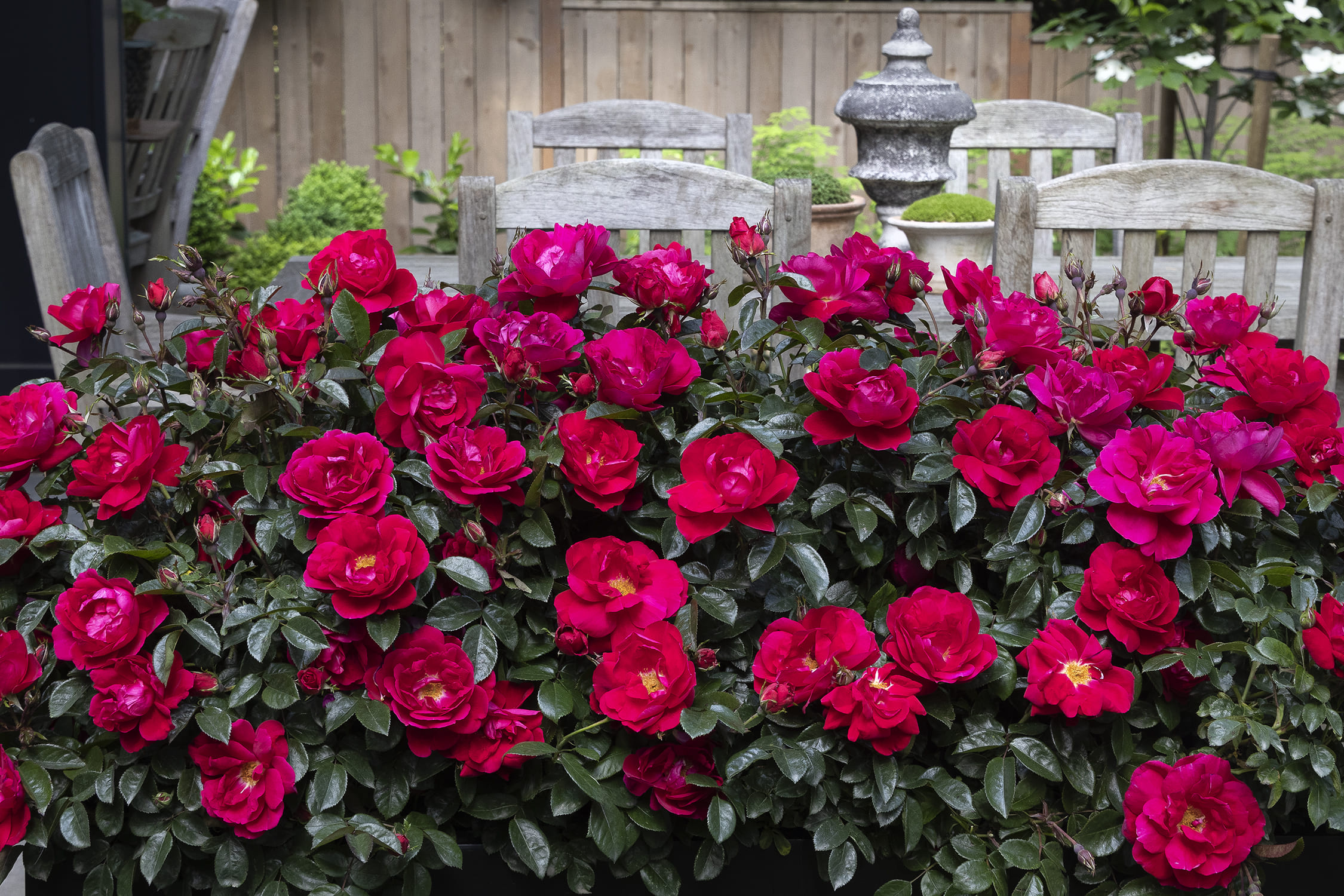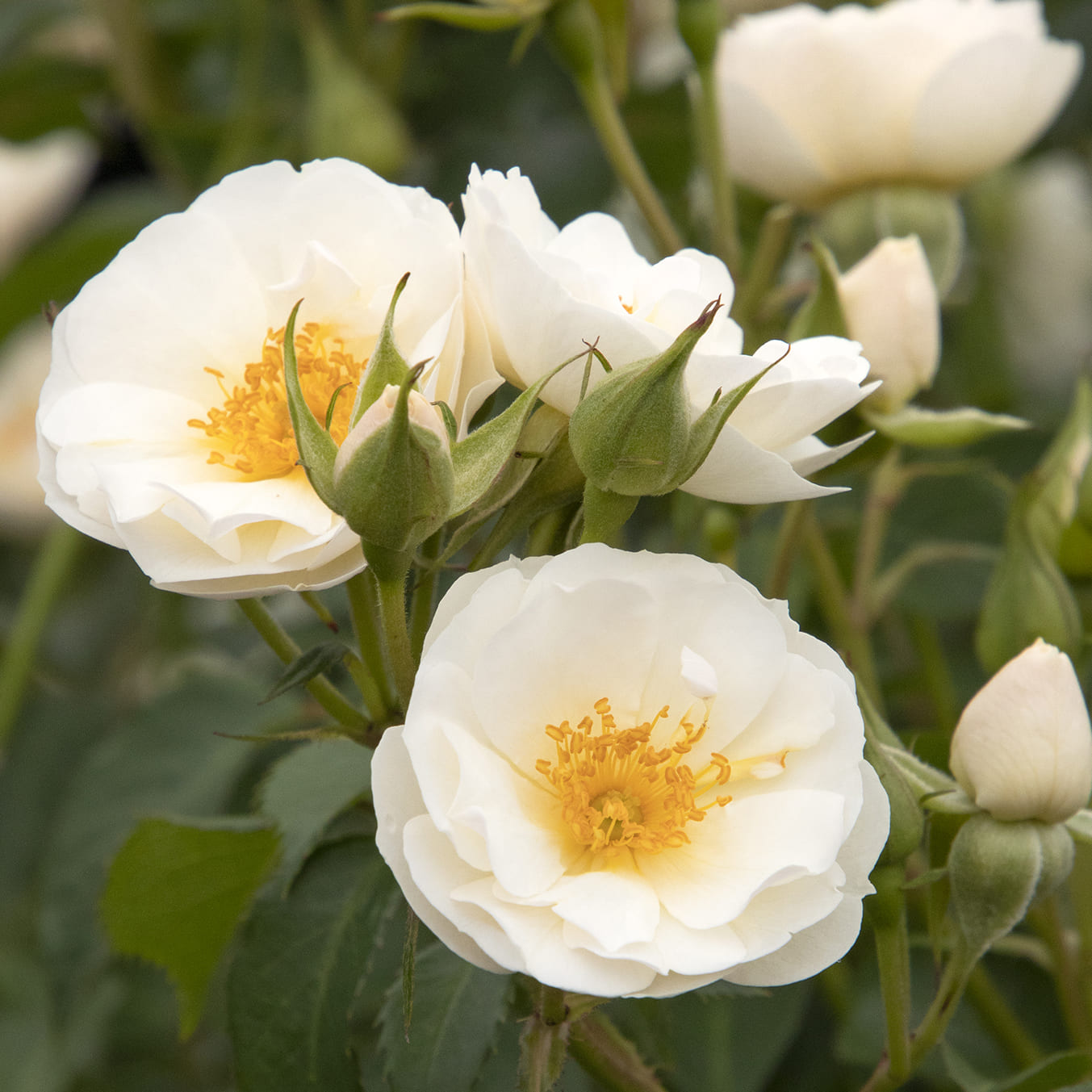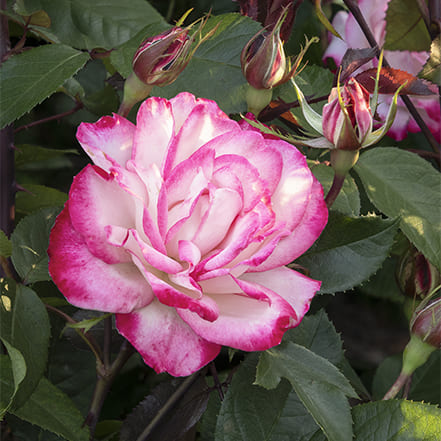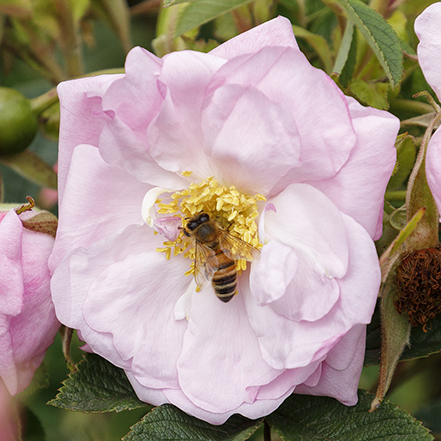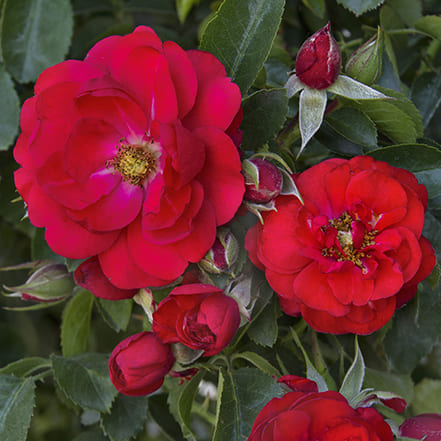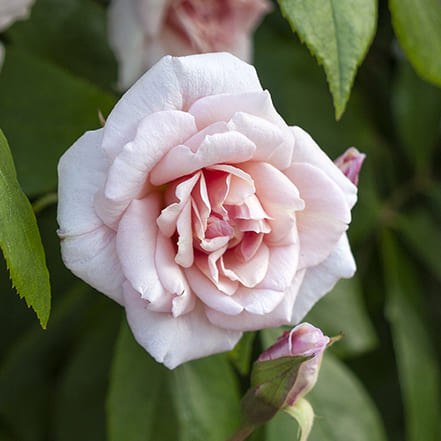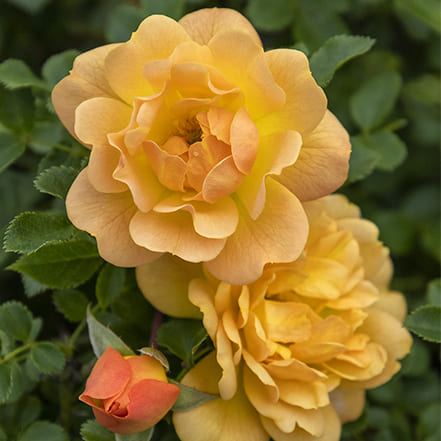Roses are cherished for their fierce blooms and timeless colors that symbolize love and beauty. Thanks to their wide variety, including a vast array of disease-resistant, thornless, and low-maintenance Monrovia-grown roses, roses can be easily be grown in gardens nationwide and bring long-lasting color year after year.
(Above) Grace N' Grit® Pink Shrub Rose is a modern rose that is disease- and mildew-resistant and self-cleaning. Grace 'N Grit® roses, like many of the modern roses Monrovia grows, do not require pruning.
While some varieties are notorious for being difficult to prune, other types of roses are a breeze to care for. We're here to help you along with a complete guide to pruning roses.
Types of Roses
First, let's differentiate between the main types of roses: tea, shrub, and climbing. It's important to know what kind of roses you have before you get started with pruning.
- Hybrid Tea Roses: Famed for their large, beautifully fragrant blooms, tea roses are the quintessential choice for a classic rose garden. These roses are a repeat-flowering, free-branching shrub of an upright or bushy habit. However, these beauties are more high maintenance than other varieties and are known to be fussy with their care requirements. Hybrid tea roses are the least hardy of the modern roses. (Note: Monrovia does not grow or sell hybrid tea roses).
- Shrub Roses: In contrast to tea roses, shrub roses are a low-maintenance gardener's dream. They include a variety of sizes, growth habits, colors, and fragrances. Shrub roses tend to bloom from late spring to fall in smaller flowers (but in greater quantities) than the hybrid tea variety. Known for their durability, disease resistance, and bushy growth habit, shrub roses are ideal for borders, hedges, and mass plantings.
- Climbing Roses: If you're looking to add vertical interest to your landscape, a climbing rose may be just what you need. These vigorous growers boast long canes that can be trained to climb walls, fences, trellises, or arbors. Climbing roses come in a variety of flower types and sizes, some of which are repeat bloomers that offer flushes of color throughout the season. Climbing roses do require initial effort in terms of training and support, but once established, they are relatively low maintenance.
Monrovia boasts beautiful collections of both climbing and shrub roses. From the delicate charm of our Cecile Brunner Climbing Rose to the fuss-free and vigorous Grace N' Grit™ Pink Shrub Rose, you're sure to find beautiful, low-maintenance roses at your local retailer in the classic green Monrovia pot.
Best Shrub Roses that Don't Need Pruning
Nitty Gritty®
White Rose
Not just a pretty face, this very durable, own-root, fuss-free groundcover rose produces an abundance of lovely blooms while offering excellent disease resistance and a self-cleaning, easy-to-care-for habit. Full sun. Up to 3' tall, 4' wide. Zones 4-9.
Grace N' Grit™ Pink
BiColor Shrub Rose
Stunning bouquets of pink and white bicolor roses on a fuss-free shrub that will endure the trials of a long, hot summer with an unwavering blooming zeal. An outstanding, disease-resistant, own-root, self-cleaning rose that thrives coast. Full sun. Up to 5' tall, 4' wide. Zones 4-9.
Seaside Swirl™ Blush
Rugosa Rose
Terrific amounts of beautiful blooms on a smaller, far more compact plant than others of its kind. Blooms from mid-spring into fall. A great, easy-care option for tough conditions. Up to 3' tall and wide. Full sun. Zones 3-9.
When To Prune Roses
Now it's time to talk pruning. As a general rule, prune your roses once a year to encourage fresh blooms. The best time to prune roses depends on your local climate and the rose type. Once-blooming rose varieties should be pruned in early summer just after they've bloomed. You can shape up these roses more in late summer, but don't do more beyond that (this can reduce the number of blooms you get the following year).
Most other types of roses should be pruned in late winter or early spring after the last frost date. This timeline varies in different regions, so check your local forecast before you head to your garden with your shears. Pruning your roses at the right time avoids the cold frost, protects your plants, and gets them trimmed up for vigorous spring growth.
It's always important to know your rose variety. Monrovia's repeat-blooming roses (like Grace 'N Grit, Nitty Gritty, and Seaside Swirl) are fuss-free and don't need to be pruned for continuous blooming. If you want to prune for size and shape, you can cut back the shrub by one-third in the spring.
Tools for Pruning Roses
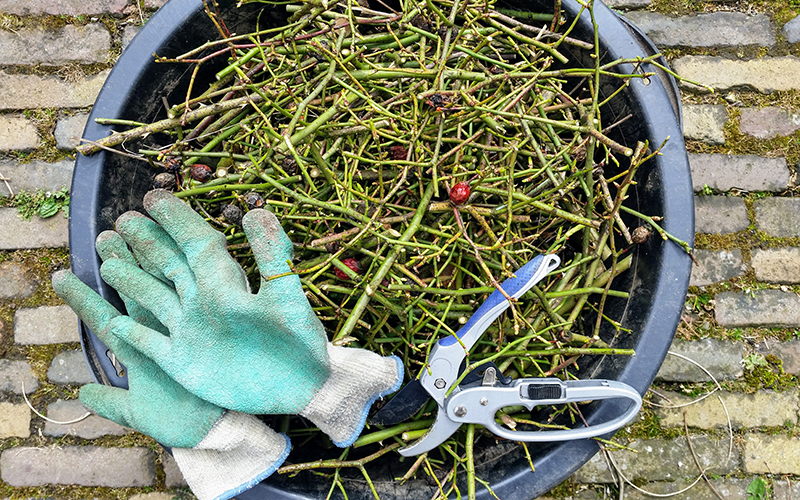
Having the right tools makes pruning roses easier and more effective. Here's what you need:
- Bypass pruning shears for clean cuts on smaller canes.
- Loppers for thicker branches that shears can't handle.
- A pruning saw for the thickest canes, usually found on older or neglected bushes.
- Gloves to protect your hands from thorns or blades.
- Long-sleeve clothing to protect your arms.
- Disinfectant for tools to prevent spreading diseases between plants.
Keep your tools clean and sharp so you can make precise cuts, which is crucial for the health of your rose bushes. Remember to clean your tools with disinfectant after each use to minimize the risk of spreading diseases.
How to Prune Roses: Tea, Shrub, and Climbing Roses
Because roses come in so many varieties, it's important to distinguish their preferred pruning methods.
How to Prune Hybrid Tea Roses
Known for their fussy nature, hybrid tea roses can be picky when it comes to pruning. Here are the basic steps:
- Remove dead wood and leaves: Begin by removing dead canes (the stems of the rose bush) and any diseased wood. Deadwood will usually appear darker and more brittle. Cut back to live wood, which usually looks green on the outside. It's also a good idea to clear away remaining leaves, and leaves are notorious for carrying pests and diseases that may have been hiding over the winter.
- Remove thin, weak growth and crossed branches: After clearing the dead and diseased wood, focus on thin, weak canes that are unlikely to support robust blooms. These are typically thinner than a pencil. Removing these allows your rose plant to direct its energy to stronger, more productive canes. Also, look through your plant for any crossed branches and remove these, too. These branches like to rub together, which can cause damage and encourage disease. You want healthy branches that stretch upward in a vase-like shape.
- Prune new growth: For the new growth, prune down to about 10 to 12 " above the ground. This will encourage new stems to grow outwards rather than inwards, improving air circulation and reducing disease risks. Make sure you cut at a 45-degree angle that slopes away from the bud so water can run off. When you are done pruning, it will look like a few short sticks jutting out of the ground. It's not pretty at first, but it's the price you pay for big, bouquet-ready blooms!
Because hybrid tea roses are tricker to grow, maintain, and prune and don't offer the same beauty as shrub and climbing roses, Monrovia doesn't grow this variety.
How to Prune Shrub Roses
Shrub roses are prized for their ease of care, and pruning is no exception. A little snip and shape can go a long way. Here's a breakdown of the process to keep your shrub roses thriving:
- Remove old canes: Remove any dead, dying, or diseased canes and branches.
- Thinning: Remove crowded or inward-growing branches to improve air circulation and light penetration within the bush. This will promote better flowering and help prevent disease.
- Renewal pruning: For mature shrub roses, consider removing 1/3 of the oldest, thickest canes at ground level. This encourages vigorous new shoots to emerge from the base, improving the plant's health and future blooms.
- Height control: To maintain a certain size or shape, you can shorten remaining healthy canes by 1/3 to 1/2 their length. Always make cuts just above an outward-facing bud to promote outward growth and bushier form.
Shrub roses are generally very forgiving when it comes to pruning. Don't be afraid to make small cuts and observe the plant's response. Always err on the side of less aggressive pruning, especially for younger plants.
How to Prune Climbing Roses
Climbing roses do require slightly different pruning techniques. While the general principles of removing dead, diseased, and weak growth still apply, pruning climbing roses means focusing on managing their growth habit (while encouraging blooms).
Here's how climbing roses differ in their pruning needs:
- Main canes: Unlike other roses, where you prune the main stems to encourage branching, climbing roses rely on established main canes for their vertical growth. Avoid pruning these main canes unless they are dead, diseased, or excessively long and unruly. You can train these main canes onto your chosen support structure (trellis, fence, etc.).
- Side shoots: The majority of your pruning effort will be directed towards the side shoots that grow off the main canes. These are where the flowers bloom. Prune these side shoots back to 2-3 inches from the main cane. This encourages them to branch out further and produce more flowers.
- Renewal pruning: Every few years (typically 3-5), consider renewal pruning for established climbing roses. This involves removing one or two of the oldest main canes at ground level to encourage new growth from the base. This will maintain the vigor of the plant and keep the lower portion from becoming bare.
Importance of Pruning Roses
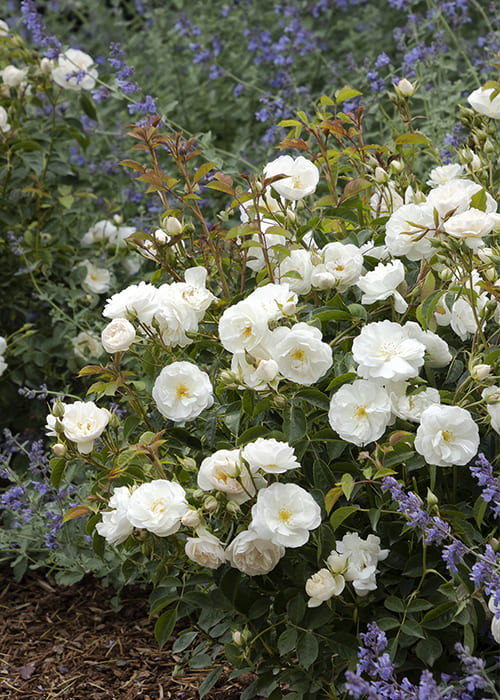
If you're experienced in growing roses, you've probably witnessed the power of pruning. Pruning is important for so many reasons:
- Promotes New Growth: By removing dead and damaged branches, your plant can direct its energy toward healthy growth. Pruning also helps stimulate the plant to produce new shoots and buds, leading to a bushier, more vigorous rose bush.
- Enhances Flowering: After pruning, your plant can focus on producing more flowers instead of maintaining weak, unproductive branches. Its remaining buds will get more sunlight and nutrients, leading to larger, more vibrant blooms.
- Maintains Shape and Size: Pruning prevents your rose plant from getting overgrown, and it gives you the chance to shape it as desired. This is great for gardens that have a clear vision of their space and want a plant that fits in perfectly.
- Improves Plant Health: Removing dead or diseased branches and leaves helps protect your plant against problems and pests so you can enjoy its beauty year after year.
Additional Questions about Pruning Roses
What angle do you prune roses?
Make cuts at a 45-degree angle about 1/4 inch above a bud facing the outside of the plant. This encourages the buds to grow outward, promoting healthy, open growth and improving air circulation among the branches.
What happens if you don't prune roses?
If you don't prune your roses, they'll likely become overgrown and dense, which causes poor air circulation in the plant. Lack of circulation can lead to diseases like powdery mildew and black spot, and it can result in fewer blooms because your plants' energy is directed toward old, unproductive wood and stems.
However, not all rose varieties are the same. While most need pruning, some repeat-blooming roses won't need to be pruned for continuous bloom. Even still, it's good practice to prune dead branches away and cut back the shrub to maintain its shape.
Popular Roses and Their Pruning Needs
Flower Carpet®
Scarlet Rose
This fuss-free rose produces a profusion of brilliant, scarlet red flowers. Blooms from spring through fall - up to ten months in warm climates. Glossy, dark green foliage is mildew and black-spot-resistant. Prune back by 1/3 annually. Full sun. Up to 2' tall, 4' wide. Zones 4-10.
Cecile Brunner
Climbing Rose
A favorite rose for cutting, especially for miniature bouquets. Small, delicately pointed buds open to fragrant, light pink, double blooms in large sprays. Keep 4-6 young stems and cut all others back to base. Full sun. Up to 20' long, 6' wide. Zones 4-11.
Itsy Bitsy® Peach
Miniature Rose
This little cutie blooms in abundance throughout the growing season, with small deep yellow and orange blooms with light blushes of pink. Has excellent resistance to mildew and rust. Prune after threat of frost to promote vigorous new growth. Full sun. Up to 18" tall, 24" wide. Zones 5-9.
Learn More About Growing Roses
- The Ultimate Rose Care Guide
- A Step-by-Step Guide to Caring for Your Roses in the Summer
- Best Roses for Containers
- Plant This Not That: Extraordinary Alternatives to Ordinary Plants
- Easy Beauty: Colorful low-maintenance plants for a beautiful garden
- Meet the Roses: The new and beautiful Grace N Grit™
- 5 Ways to Design with Roses
- Romancing the Roses: Fill your garden with these flowers
- For the Love of Roses: A look into America's favorite flower




